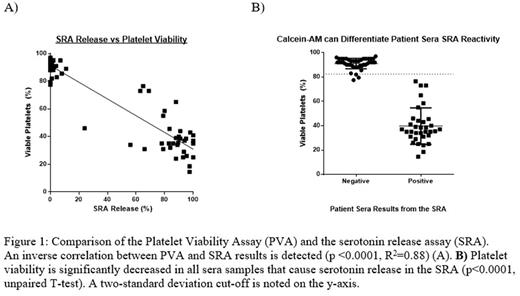Abstract
Background: Heparin-induced thrombocytopenia (HIT) is an adverse drug reaction that causes platelet activation, leading to thrombocytopenia and a high risk of thrombosis. Platelet activation is induced by antibodies that bind to the complex of platelet factor 4 (PF4), a platelet α-granule protein, and heparin, a common blood anticoagulant. The 14C-serotonin release assay (SRA) is considered the gold standard functional assay for HIT testing due to its high sensitivity and specificity. Positive results in the SRA correlate strongly with clinical HIT; however, the SRA also requires radioactive serotonin as an endpoint marker and this limits its availability for use in diagnostic testing. In this study, we developed a platelet viability assay (PVA) using Calcein-AM, a fluorescent viability dye, as a marker to identify platelet-activating antibodies in patients with HIT.
Methods: Patient sera were tested in parallel in the SRA and PVA and the results were compared and correlated for sensitivity and specificity. The SRA was performed using 14C-serotonin-labelled donor target platelets (350,000/µL; 75µL per test) incubated with 20µL of test serum and 5µL of heparin (0.1 U/mL).1 Following the reaction (60 minutes, room temperature), 100 µL of 5mM PBS/EDTA was added and the amount of 14C-serotonin released in the supernatant was measured.
In our novel PVA, following the initial incubations with serum and heparin, platelets were stained with 2 µl of Calcein-AM (2 µg/mL final concentration) for 30 minutes at 37⁰C. 150 µl of 5mM PBS/EDTA was added and the fluorescence intensity of platelets was measured via flow cytometry (488nm excitation; Cytoflex). Platelet viability was reported as the percentage of platelets that maintained Calcein-AM fluorescence intensity relative to control. In total, 35 SRA-positive and 43 SRA-negative sera were tested.
Results: In the PVA, the percentage of viable platelets were 91±4% for sera that were negative in the SRA (n=43); and 39±14% for sera that were positive in the SRA (n=35) (figure 1). Using a cut off defined as two-standard deviations from the mean of negative sera, sensitivity of the PVA was 100% and specificity was 93%. These results were consistent across different donor platelets. An inverse linear correlation (R=0.93) was observed between platelet viability in the PVA and serotonin release in the SRA.
Conclusions:The PVA can accurately differentiate SRA positive from SRA negative HIT sera. Advantages of the PVA are that the assay is flow-cytometry based, and uses an inexpensive, easy to handle and a readily available endpoint marker for measuring platelet activation. Further prospective studies are needed to optimize the assay to develop a useful functional assay for HIT diagnosis.
Arnold: Dova: Consultancy; Amgen: Consultancy, Research Funding; Rigel: Consultancy; Bristol Myers Squibb: Research Funding; Novartis: Consultancy, Research Funding; UCB: Consultancy.
Author notes
Asterisk with author names denotes non-ASH members.


